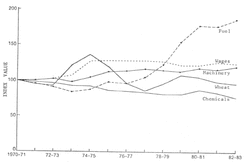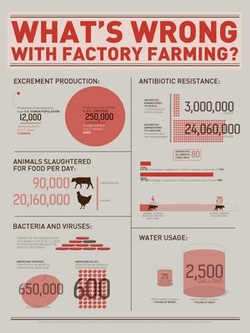Family Farming in America
"Small family farms are at least as efficient as larger operations. In fact, there is evidence of diseconomies of scale as farm size increase."
-Willis Peterson, University of Minnesota analyst
-Willis Peterson, University of Minnesota analyst
As family farming is drastically decreasing, industrial farming has rapidly increased. A correlation between the two? Yes.
Industrial farms cause smaller farms to go out of business by mass producing food. Efficiency is they key to production, despite the use of unnatural chemicals, genetic engineering, and inhumane methods of treating livestock. So Why Do We Support Industrial Farming? Increased amounts of food mean that food prices can drop and make it easier for consumers to feed themselves and their families. With a growing population, the government supports industrial farming. Industrial farming has become a big business, vertically integrated as exhibited by Cargill and ConAgra.
Another trend in America is "bigness." That implies larger acreage and field equiptment, two factors that family farmers can not afford. However, nore acreage does not mean more job opportunities. Large corporations only create 9.44 jobs, displacing 27.97. Larger farms also use methods of farming that are detrimental to the earth. Farms on a smaller scale use crop diversification, border cropping, sequential, and crop rotation. While corporate farms use monoculture, meaning that the same crop is grown all season. This form of planting leads to empty niche spaces. Erosion and weed infestation are a result. Although large farms are known for greater total yield per crop, smaller farms usually have a greater total yield per unit area.
Corporate farming creates less farms, meaning more crime. Also, the reduction of the middle class is no longer, and families are not as unified. According to Farm Aid, 330 famers leave their land every week. To replace the empty spaces of the agricultural market will be a few large corporate companies.
Larger industrial farms don the title of "organic" to their products, a misconception to the average consumer. In fact, the word organic is so misconcieved as healthy and safe in this case that competition with local farmers has arisen. For example, Cascadian Farms and Muir Glen are owned by Small Planet Foods. General Mills, the third biggest food corporation in North America, uses Small Planet Foods as its organic marketing. Though there are negative impacts on the environment and low nutritional value in their foods, the conglomerate is funded by even larger industries. Some investors include Exxon/Mobil, Philip Morris, McDonald's, Nike, Dupont, Dow Chemical, Pepsico, Disney, Texas Instruments. Weapons producers and fast food chains have replaced wholesale food contributors. In 1982 there were 28 wholesale distributors in the United States, while in 2003, there were only 3.
"Growth for capitalist economies demands ever increasing profit, based on expansion. Family owned and "small" businesses give way to larger and larger enterprises, until Walmart finally replaces the local variety stores, and Wegmans replaces the neighborhood food markets."
-Carole Resnick
-Carole Resnick

Heavily processed food means a higher fat and calorie content. Our yearly per capita sugar consumption has risen from 128-158 pounds since 1985. Since 1977, the average calorie intake has increased 10%. Obesity is a prominent issue in our society, as doctors characterize 3/5 children as overweight, with a chance of diabetes being 1/3.
Organic food IS NOT local food. Local food implies that the food is grown within the community. Though organic food is ofter associated, it can be just as widely transported as processed food. In fact, the food we eat comes from across the country or world since vast amounts of of corn and soybean are converted into animal feed or processed food ingredients. The food is typical to have travceled 1,500 miles or more before it reaches the store. One of the major uses of fuel in the country is in transporting the nation's food. More specifically, 1/5 of the country's petroleum production is used in the shipment and production of our food.
Foodborne illnesses are more prevalent in industrial-grown foods, as fruits and vegetables are contaminated with pesticides and hormones are added to our milk. The risks of these supposedly "safe, nutritious, and healthy" foods include cancer caused from pesticides on food or runoff in water, greater obesity as the intake of processed foods rise, and contamination from x-rays used to remove bacteria from food. New technology, however, does not reduce the ever relevant foodborne illness epidemics. As yet another consequence of these industrial products, food borne illnesses such as ecoli and salmonella infect 80 million people a year and are responsible for killing over 9000 in the United States alone. Foodborne illnesses are the product of the industrialization of the poultry and meat industries as well as the use of antibiotics in farming.
The treatment of livestock is another major concern in corporate farming. CAFO stands for concentrated animal feeding operations, defined as operations which confine animals. The total stability period is 45 days or more. A large CAFO will contain 1000 cattle other than dairy, 2500 hogs over 55 pounds, 125000 chickens, and 30-82000 laying hens. A medium CAFO will contain 300-999 cattle other than dairy, 750-2499 hogs if 55 pounds or more, and 375000-124999 chickens. The substitution of structures and equiptment for land and labor is a catalyst for the transition from family farming to industrial farming.
Organic food IS NOT local food. Local food implies that the food is grown within the community. Though organic food is ofter associated, it can be just as widely transported as processed food. In fact, the food we eat comes from across the country or world since vast amounts of of corn and soybean are converted into animal feed or processed food ingredients. The food is typical to have travceled 1,500 miles or more before it reaches the store. One of the major uses of fuel in the country is in transporting the nation's food. More specifically, 1/5 of the country's petroleum production is used in the shipment and production of our food.
Foodborne illnesses are more prevalent in industrial-grown foods, as fruits and vegetables are contaminated with pesticides and hormones are added to our milk. The risks of these supposedly "safe, nutritious, and healthy" foods include cancer caused from pesticides on food or runoff in water, greater obesity as the intake of processed foods rise, and contamination from x-rays used to remove bacteria from food. New technology, however, does not reduce the ever relevant foodborne illness epidemics. As yet another consequence of these industrial products, food borne illnesses such as ecoli and salmonella infect 80 million people a year and are responsible for killing over 9000 in the United States alone. Foodborne illnesses are the product of the industrialization of the poultry and meat industries as well as the use of antibiotics in farming.
The treatment of livestock is another major concern in corporate farming. CAFO stands for concentrated animal feeding operations, defined as operations which confine animals. The total stability period is 45 days or more. A large CAFO will contain 1000 cattle other than dairy, 2500 hogs over 55 pounds, 125000 chickens, and 30-82000 laying hens. A medium CAFO will contain 300-999 cattle other than dairy, 750-2499 hogs if 55 pounds or more, and 375000-124999 chickens. The substitution of structures and equiptment for land and labor is a catalyst for the transition from family farming to industrial farming.

